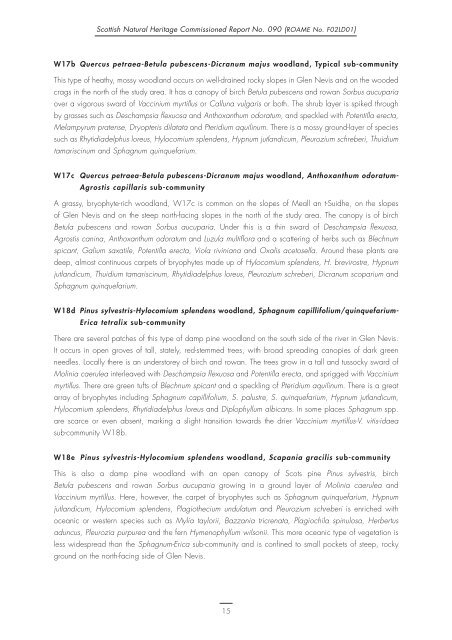A survey of the vegetation of Ben Nevis - Scottish Natural Heritage
A survey of the vegetation of Ben Nevis - Scottish Natural Heritage
A survey of the vegetation of Ben Nevis - Scottish Natural Heritage
Create successful ePaper yourself
Turn your PDF publications into a flip-book with our unique Google optimized e-Paper software.
<strong>Scottish</strong> <strong>Natural</strong> <strong>Heritage</strong> Commissioned Report No. 090 (ROAME No. F02LD01)<br />
W17b Quercus petraea-Betula pubescens-Dicranum majus woodland, Typical sub-community<br />
This type <strong>of</strong> heathy, mossy woodland occurs on well-drained rocky slopes in Glen <strong>Nevis</strong> and on <strong>the</strong> wooded<br />
crags in <strong>the</strong> north <strong>of</strong> <strong>the</strong> study area. It has a canopy <strong>of</strong> birch Betula pubescens and rowan Sorbus aucuparia<br />
over a vigorous sward <strong>of</strong> Vaccinium myrtillus or Calluna vulgaris or both. The shrub layer is spiked through<br />
by grasses such as Deschampsia flexuosa and Anthoxanthum odoratum, and speckled with Potentilla erecta,<br />
Melampyrum pratense, Dryopteris dilatata and Pteridium aquilinum. There is a mossy ground-layer <strong>of</strong> species<br />
such as Rhytidiadelphus loreus, Hylocomium splendens, Hypnum jutlandicum, Pleurozium schreberi, Thuidium<br />
tamariscinum and Sphagnum quinquefarium.<br />
W17c Quercus petraea-Betula pubescens-Dicranum majus woodland, Anthoxanthum odoratum-<br />
Agrostis capillaris sub-community<br />
A grassy, bryophyte-rich woodland, W17c is common on <strong>the</strong> slopes <strong>of</strong> Meall an t-Suidhe, on <strong>the</strong> slopes<br />
<strong>of</strong> Glen <strong>Nevis</strong> and on <strong>the</strong> steep north-facing slopes in <strong>the</strong> north <strong>of</strong> <strong>the</strong> study area. The canopy is <strong>of</strong> birch<br />
Betula pubescens and rowan Sorbus aucuparia. Under this is a thin sward <strong>of</strong> Deschampsia flexuosa,<br />
Agrostis canina, Anthoxanthum odoratum and Luzula multiflora and a scattering <strong>of</strong> herbs such as Blechnum<br />
spicant, Galium saxatile, Potentilla erecta, Viola riviniana and Oxalis acetosella. Around <strong>the</strong>se plants are<br />
deep, almost continuous carpets <strong>of</strong> bryophytes made up <strong>of</strong> Hylocomium splendens, H. brevirostre, Hypnum<br />
jutlandicum, Thuidium tamariscinum, Rhytidiadelphus loreus, Pleurozium schreberi, Dicranum scoparium and<br />
Sphagnum quinquefarium.<br />
W18d Pinus sylvestris-Hylocomium splendens woodland, Sphagnum capillifolium/quinquefarium-<br />
Erica tetralix sub-community<br />
There are several patches <strong>of</strong> this type <strong>of</strong> damp pine woodland on <strong>the</strong> south side <strong>of</strong> <strong>the</strong> river in Glen <strong>Nevis</strong>.<br />
It occurs in open groves <strong>of</strong> tall, stately, red-stemmed trees, with broad spreading canopies <strong>of</strong> dark green<br />
needles. Locally <strong>the</strong>re is an understorey <strong>of</strong> birch and rowan. The trees grow in a tall and tussocky sward <strong>of</strong><br />
Molinia caerulea interleaved with Deschampsia flexuosa and Potentilla erecta, and sprigged with Vaccinium<br />
myrtillus. There are green tufts <strong>of</strong> Blechnum spicant and a speckling <strong>of</strong> Pteridium aquilinum. There is a great<br />
array <strong>of</strong> bryophytes including Sphagnum capillifolium, S. palustre, S. quinquefarium, Hypnum jutlandicum,<br />
Hylocomium splendens, Rhytidiadelphus loreus and Diplophyllum albicans. In some places Sphagnum spp.<br />
are scarce or even absent, marking a slight transition towards <strong>the</strong> drier Vaccinium myrtillus-V. vitis-idaea<br />
sub-community W18b.<br />
W18e Pinus sylvestris-Hylocomium splendens woodland, Scapania gracilis sub-community<br />
This is also a damp pine woodland with an open canopy <strong>of</strong> Scots pine Pinus sylvestris, birch<br />
Betula pubescens and rowan Sorbus aucuparia growing in a ground layer <strong>of</strong> Molinia caerulea and<br />
Vaccinium myrtillus. Here, however, <strong>the</strong> carpet <strong>of</strong> bryophytes such as Sphagnum quinquefarium, Hypnum<br />
jutlandicum, Hylocomium splendens, Plagio<strong>the</strong>cium undulatum and Pleurozium schreberi is enriched with<br />
oceanic or western species such as Mylia taylorii, Bazzania tricrenata, Plagiochila spinulosa, Herbertus<br />
aduncus, Pleurozia purpurea and <strong>the</strong> fern Hymenophyllum wilsonii. This more oceanic type <strong>of</strong> <strong>vegetation</strong> is<br />
less widespread than <strong>the</strong> Sphagnum-Erica sub-community and is confined to small pockets <strong>of</strong> steep, rocky<br />
ground on <strong>the</strong> north-facing side <strong>of</strong> Glen <strong>Nevis</strong>.<br />
15

















